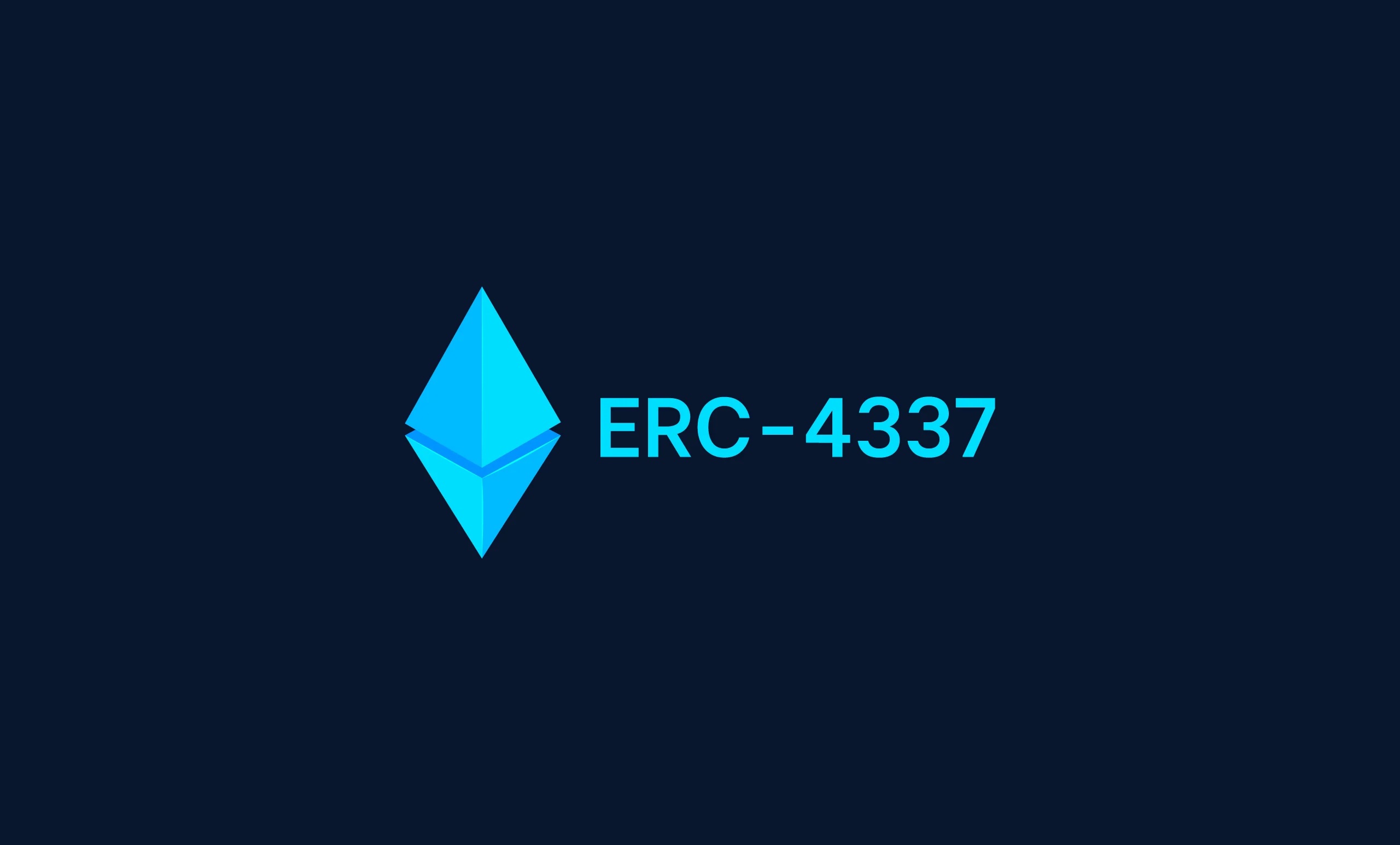Account Abstraction ERC-4337: How Does It Improve Crypto Transaction Experience?
Account Abstraction ERC-4337 introduces a new level of efficiency and security, addressing concerns that may have hindered widespread acceptance of cryptocurrencies. Today, let’s learn about this interesting topic with Coincu.
What is Account Abstraction?
Ethereum Account Abstraction
In a groundbreaking development for the Ethereum network, the concept of Account Abstraction (AA) has taken center stage, offering users unprecedented flexibility in managing their transactions.
This innovative proposal allows for the conversion of traditional account types into smart contracts, each equipped with its own logic to independently determine the validity of transactions, handle transaction fees, and initiate transactions.
A Paradigm Shift in Ethereum Accounts
In the realm of computer science, these accounts are aptly termed “abstracted,” giving rise to the term Account Abstraction. The core idea behind this paradigm shift is to eliminate the conventional practice of using a single account for all purposes. Instead, the proposal advocates for a separation between the entities responsible for holding tokens (accounts) and those authorizing or allowing token transactions (signers).
This strategic move aims to empower users with the ability to tailor their accounts to suit their individual needs. Users who seek alternative signature verification algorithms, employ multiple keys for transaction authorization, or regularly change account signers can now create separate accounts to seamlessly manage these aspects.
Vitalik Buterin’s Journey from EIP-86 to EIP-4337
While the concept of Account Abstraction is not entirely new, Ethereum co-founder Vitalik Buterin first introduced it in the EIP-86 proposal back in 2017. However, the initial proposal required extensive protocol changes, making implementation challenging. Subsequently, Buterin refined the concept with EIP-2938 and the latest iteration, EIP-4337, streamlining the deployment process.
Notably, two prominent projects have officially embraced the application of Account Abstraction: StarkNet and zkSync version 2.0. These Layer 2 projects are at the forefront of adopting this transformative approach, signaling a new era in Ethereum’s evolution.
What is Account Abstraction ERC-4337?
The Account Abstraction ERC-4337 standard is a token standard, opening new avenues for the utilization of smart contract crypto wallets. It represents a breakthrough in the Ethereum ecosystem, offering a powerful mechanism for smart contract crypto wallets to seamlessly integrate and operate on the blockchain.
Account abstraction, a key feature of ERC-4337, enables smart contract crypto wallets to transcend traditional limitations, providing users with unprecedented control and flexibility over their digital assets. This advancement is poised to redefine the user experience within the Ethereum ecosystem, making transactions and interactions with smart contracts more intuitive and user-friendly.
History of Account Abstraction ERC-4337
Unveiling the Challenges in Crypto Adoption
The dynamic landscape of the cryptocurrency market, marked by the rise of DeFi and the popularity of NFTs, has undeniably captured the attention of the financial community. However, a significant barrier preventing millions of potential users from fully embracing the crypto space lies in the complexities of user interfaces, security concerns, and the risk of losing assets.
Security Concerns Amidst Centralized Exchanges
Navigating the crypto market often proves challenging due to intricate technical processes and the potential loss of assets, particularly for individuals unfamiliar with blockchain technology.
Centralized exchanges (CEX) compound these challenges, with users expressing fears over the safety and security of their assets, especially in the wake of the FTX exchange collapse, which resulted in substantial losses for many investors.
The Perils of Forgetting Private Keys and Seed Phrases
The use of seed phrases, also known as recovery phrases, poses yet another security challenge. While these phrases serve as a means to restore a user’s wallet address in case of forgotten passwords or when switching to a new device, their vulnerability to theft raises concerns.
If a seed phrase falls into the wrong hands, unauthorized access to the user’s account becomes a significant threat, potentially resulting in unauthorized transactions and compromising the security of digital assets.
The issue of forgetting private keys and seed phrases further exacerbates the risks associated with crypto investments. Numerous cases have been reported where investors lost substantial sums due to forgetting or inadvertently revealing their private keys, leading to the complete loss of assets stored in their wallets.
DeFi Dapps and the Dilemma of Dual Addresses
Interacting with DeFi decentralized applications (dApps) presents additional difficulties, as users are required to manage two distinct addresses: their wallet address (Externally Owned Accounts – EOA), such as MetaMask or Zerion, and contract accounts programmed through smart contracts.
Each transaction confirmation on the EOA wallet address incurs gas fees in the native coin of the blockchain (e.g., ETH, AVAX, BNB), adding complexity and limitations for users.
Account Abstraction ERC-4337 Born
Addressing these challenges, a groundbreaking solution has emerged in the form of ERC-4337. Developed and deployed through the EntryPoint smart contract in March 2023, ERC-4337 is an AA standard co-authored by visionaries such as Vitalik Buterin, Yoav Weiss, Kristof Gazso, Dror Tirosh, Shahaf Nacson, and Tjaden Hess.
ERC-4337 introduces account abstraction without modifying the core protocol. By replicating the functionality of the transaction mempool in a higher-level system, the standard enables users to send UserOperation objects to Ethereum nodes. These objects are then packaged into a single transaction, seamlessly included in the Ethereum chain.
The components of Account Abstraction ERC-4337
Pseudo-Transactions with UserOperation
ERC-4337 introduces a revolutionary concept known as “pseudo-transactions” through a new object named UserOperation. This innovation aims to streamline the transaction process by allowing the initiation of transactions on behalf of users.
Alt Mempool, Bundler Nodes
The UserOperation transactions that are yet to be confirmed find their home in what is referred to as an “alt mempool,” a designated space for unconfirmed transactions.
Adding another layer to this process, nodes within the Ethereum network now have the option to function as Bundlers. These Bundlers aggregate multiple UserOperations, packaging them into a singular transaction known as a bundle transaction.
EntryPoint
The culmination of these bundle transactions occurs at a global smart contract named the “EntryPoint,” the singular entry point on the Ethereum blockchain. The EntryPoint is a pivotal element in the process, acting as a centralized hub for the bundled transactions initiated by the Bundlers.
handleOps Function
At the heart of the EntryPoint is a crucial function named “handleOps.” When invoked, this function receives the bundle transaction and subsequently triggers a distinctive function called “validateUserOp” for each account associated with the transaction.
validateUserOp
The primary objective of validateUserOp is two-fold. First, it authenticates the signature of the operation, ensuring the security and integrity of the transaction. Second, it evaluates the operation in alignment with the account’s specifications. If the criteria are met, the gas fee payment corresponding to the operation is processed.
As a subsequent step, each smart contract wallet linked to the EntryPoint contract must implement an additional function to execute the received operation. This implementation transforms the entire process into a programmatic sequence, alleviating users from the burdensome task of managing private key dependencies and navigating through tedious processes.

How Account Abstraction ERC-4337 Works
Let’s delve into the intricacies of how Account Abstraction ERC-4337 operates, providing a comprehensive understanding of its functions.
User Transaction Workflow
The operation of Account Abstraction ERC-4337 is a multi-step process that ensures the efficient execution of user transactions on the blockchain:
Initiated by the user, an operation, such as a click, triggers the packaging of user transaction actions into User Operations. These operations are then sent to the mempool, serving as a waiting room for unconfirmed transactions.
The mempool forwards the packaged information to Bundles, which function akin to validators and miners but operate at the account functionality level. Bundles play a crucial role in bringing information into blocks on Ethereum or any other blockchain utilizing the Ethereum Virtual Machine (EVM).
The Entry Point smart contract processes User Operations in two stages:
- Verification Loop: Validates the User Operation by cross-referencing it with the Account and Paymaster. It ensures that the Account or Paymaster can cover the maximum gas cost for each User Operation.
- Execution Loop: Sends callData, the data transferred to the Autonomous Agent (AA) address for execution, to the Account. Unused gas fees are refunded to the Account, or the Paymaster is requested to cover the required logical fees.
The Account evaluates whether to accept the User Operation during the Verification round. Additionally, this stage accommodates additional features, such as support for social recovery and multi-action functionalities.
Advantages Of Account Abstraction ERC-4337
Liberation from Seed Phrases with ERC-4337
One of the standout features of ERC-4337 is the liberation from the reliance upon seed phrases for secure wallets. Traditional wallets often face vulnerabilities associated with the loss or hacking of seed phrases.
However, ERC-4337 eliminates this concern by introducing alternative security measures such as two-factor authentication and biometrics, akin to those found in traditional banking practices. This shift towards friendlier wallet protection methods can significantly reduce risks and enhance the overall user experience.
Smart Contract Wallets and Error Reduction
Moreover, the incorporation of smart contract wallets within ERC-4337 significantly diminishes the potential for human error, thereby amplifying operational accuracy.
Unlike conventional wallets, ERC-4337 ensures that a user’s private key is not directly used to control the assets within an account but only to authorize the execution of a smart contract. This not only minimizes the risk of unauthorized access but also strengthens the security of the entire blockchain network.
Account Abstraction ERC-4337 Across Diverse Blockchain Networks
Another notable advantage of ERC-4337 lies in its compatibility with diverse blockchains. This standard can be seamlessly integrated into networks that support the Ethereum Virtual Machine, including but not limited to Polygon, Avalanche, Arbitrum, and several others.
The ease with which adaptations can be aggregated across different blockchains enhances the versatility of ERC-4337, making it a powerful tool for blockchain developers and users alike.
Multi-Signature Systems and Limited Payments with Account Abstraction ERC-4337
In contrast to conventional EOA wallets, where users have the binary choice of either providing full access or none at all, ERC-4337 introduces a more nuanced approach. Account abstraction wallets enable users to design multi-signature systems, requiring the authorization of two or more users for the execution of a transaction.
This added layer of security provides users with greater control over their assets, reducing the risk of unauthorized transactions. Additionally, ERC-4337 offers the option to add users with limited payment capabilities to specific wallets within a designated time frame, further enhancing flexibility and control.
For Developers
Developers can now create wallets for users seamlessly as they sign up for applications, simplifying the onboarding process.
ERC-4337 enables users to conduct multiple transactions within a specified period without the need for signatures on each transaction, providing a more fluid and efficient experience.
Developers no longer need to navigate the complexities of each blockchain. As long as the wallet supports ERC-4337, it can be effortlessly deployed and utilized on any Ethereum Virtual Machine (EVM) blockchain.
One of the most notable features for developers is the ability to pay gas fees on behalf of users, streamlining transaction processes and enhancing user convenience.
For Users
ERC-4337 empowers users to create e-wallets effortlessly by utilizing social account information on various blockchain EVMs. This eliminates the need to remember cumbersome 12 seed phrases, enhancing accessibility for users.
Users can now pay gas fees with ERC20 tokens or non-ETH assets, providing a more versatile and user-friendly approach to managing transaction costs.
The new protocol allows users to make multiple transactions simultaneously. For instance, users with USDC can seamlessly exchange it for ETH, execute transactions, and cover fees with ETH in a single, streamlined transaction.
ERC-4337 introduces automatic, recurring payments for services such as Netflix and New York Times, offering users unparalleled convenience in managing subscription-based transactions.
Users gain greater control over their assets through options like adding or deleting devices, restoring wallets with friends, and securing wallets with 2FA (two-factor authentication) or biometrics.
Users can now limit the amount of assets traded, a crucial feature when managing gas fees, providing a more nuanced and controlled approach to asset transactions.
Some other benefits
Decentralization Reinvented
ERC-4337 takes decentralization to new heights by introducing account abstraction. This innovative approach ensures an anti-fragile system with no single point of failure, enhancing the overall robustness of the ecosystem. The protocol’s commitment to being censorship-resistant aligns seamlessly with the foundational principles of decentralized networks.
Seamless Integration without Hard Forks
A notable feature of ERC-4337 is its ability to facilitate account abstraction without necessitating a hard fork. This is achieved through the ingenious design of the higher-level UserOp mempool. The protocol allows for adoption without requiring consensus protocol changes, streamlining the integration process for developers and minimizing disruptions within the blockchain network.
Revolutionizing Gas Abstraction
One of the key strengths of the ERC-4337 lies in its gas abstraction capabilities. The introduction of paymasters marks a paradigm shift, reducing user experience friction.
Users can now pay network fees with ERC-20 tokens instead of being confined to ETH, introducing unprecedented flexibility. Moreover, the protocol opens doors to innovative possibilities by enabling users to delegate the responsibility of covering fees to third parties, expanding the horizons of transaction possibilities.
Disadvantages of Account Abstraction ERC-4337
Higher Transaction Fees
One notable drawback of ERC-4337 is the comparatively higher fees for simple transfers. This is due to the necessity of a contract call with ERC-4337, making transactions more expensive than those conducted through traditional wallets (EOAs). However, it is worth noting that on rollups, ERC-4337 could potentially be more cost-effective than EOAs, as it can aggregate signatures to reduce data on the mainnet.
Unfinalized Standard
Another significant challenge lies in the fact that the standard for ERC-4337 has not yet been finalized. This introduces several concerns, including the potential for increased attack vectors due to extended transaction extensibility. Migrating to the new standard may also pose risks such as unforeseen bugs or security vulnerabilities. Additionally, there is a need for a robust and secure global entry point contract to ensure the proper signing and validation of all transactions.
Security Vulnerabilities
The most pressing issue associated with account abstraction is the vulnerability it introduces. There is a genuine risk of smart contract users’ funds being compromised, with hackers potentially siphoning off funds. As security is paramount in the blockchain space, addressing and mitigating these vulnerabilities is crucial for the widespread adoption of ERC-4337.
Data and Privacy Concerns
Account Abstraction ERC-4337 raises concerns about data and privacy breaches. If developers fail to implement adequate security measures, users’ data could be accessed by malicious actors. Safeguarding user information is essential for maintaining trust within the blockchain community, emphasizing the need for robust security protocols.
Conclusion
Account Abstraction ERC-4337 is ushering in a transformative era. Departing from the conventional simple EOA model, known for its susceptibility to total loss from minor errors, ERC-4337 envisions a future where accounts become customizable through smart contracts, catering to individual needs.
In conclusion, Account Abstraction ERC-4337 is not merely a technical upgrade but a groundbreaking development that reshapes the landscape of cryptocurrency management. It addresses vulnerabilities inherent in traditional models and paves the way for a future where cryptocurrencies and Web3 technologies can achieve broader acceptance.
DISCLAIMER: The information on this website is provided as general market commentary and does not constitute investment advice. We encourage you to do your own research before investing.




























